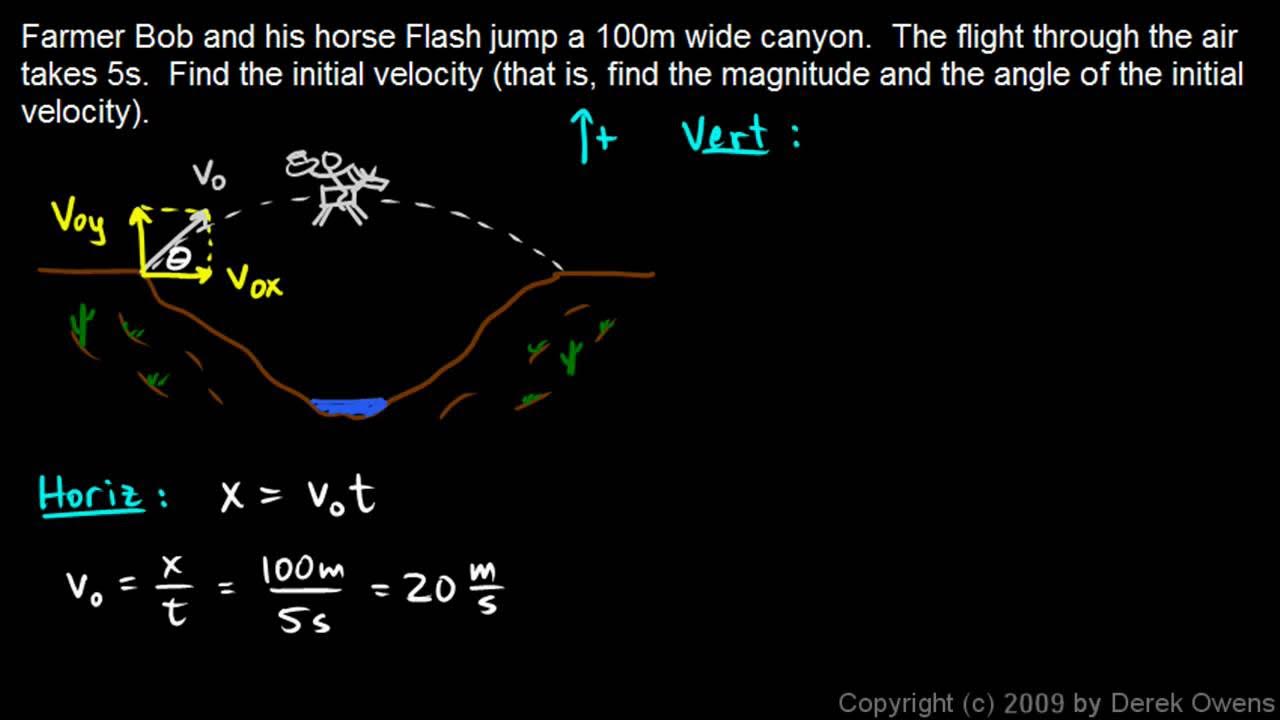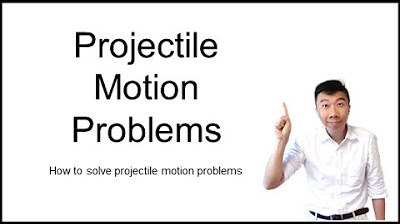AP Physics B Kinematics Presentation #77
TLDRThe script explains the physics of a ball thrown at 8 m/s at a 35° angle, undergoing projectile motion. It emphasizes that horizontal velocity remains constant throughout the motion, while the vertical component changes direction but maintains the same magnitude due to no net work being done in the vertical direction. The key takeaway is that the speed of the ball when it returns to the original horizontal level is the same as the initial speed, which is 8 m/s, as demonstrated through the equations of motion.
Takeaways
- 🚀 The ball is thrown with an initial speed of 8 m/s at a 35° angle above the horizontal.
- 📏 The problem focuses on the speed of the ball when it returns to the same horizontal level, ignoring direction.
- 🔄 The horizontal velocity (Vx) remains constant throughout the motion due to no acceleration in the horizontal direction.
- 🔽 The vertical velocity (Vy) changes in direction but not in magnitude from the initial to the final position.
- 📐 The formula V^2 = u^2 + 2as is used to analyze the vertical component of the velocity, where 'a' is acceleration and 's' is displacement.
- ⏱ At the initial and final positions, the vertical displacement (Δy) is zero, simplifying the equation to Vf^2 = Vi^2 for the vertical component.
- 🔃 The final vertical velocity (Vfy) is equal in magnitude but opposite in direction to the initial vertical velocity (Viy).
- 🔢 The magnitude of the final velocity (Vf) is calculated using the Pythagorean theorem, Vf = √(Vx^2 + Vfy^2).
- 🔄 The final velocity's magnitude is shown to be the same as the initial velocity's magnitude, which is 8 m/s.
- 🎯 The conclusion is that the speed of the ball when it returns to the same horizontal level is also 8 m/s, demonstrating that the initial and final speeds are equal.
Q & A
What is the initial speed of the ball when thrown?
-The initial speed of the ball is 8 m/s.
At what angle is the ball thrown above the horizontal?
-The ball is thrown at an angle of 35° above the horizontal.
What is the significance of the horizontal velocity (Vx) in projectile motion?
-The horizontal velocity (Vx) remains constant throughout the projectile motion because there is no acceleration in the horizontal direction.
Why does the vertical velocity (Vy) change during the projectile motion?
-The vertical velocity (Vy) changes due to the acceleration due to gravity acting on the ball, causing it to slow down as it ascends and speed up as it descends.
What is the formula used to relate the initial and final vertical velocities?
-The formula used is V^2 = u^2 + 2 * a * Δy, where V is the final vertical velocity, u is the initial vertical velocity, a is the acceleration due to gravity, and Δy is the change in vertical position.
Why is the final vertical velocity (Vfy) negative when the ball returns to the same horizontal level?
-The final vertical velocity (Vfy) is negative because it is in the downward direction, opposite to the initial upward direction of the throw.
How does the magnitude of the final velocity compare to the initial velocity?
-The magnitude of the final velocity is the same as the initial velocity because the changes in vertical velocity due to gravity are symmetrical during the ascent and descent.
What does it mean for the speed of the ball to be the same when it returns to the same horizontal level?
-It means that the magnitude of the velocity, or the speed, is the same at the beginning and end of the projectile motion, which is 8 m/s in this case.
Why is the horizontal component of the velocity (Vx) not affected by gravity?
-The horizontal component of the velocity (Vx) is not affected by gravity because gravity acts vertically, and there is no horizontal acceleration.
What is the role of the angle of projection in determining the path of the ball?
-The angle of projection determines the initial vertical and horizontal components of the velocity, which in turn dictate the trajectory of the ball in projectile motion.
How does the script demonstrate that the initial and final velocities are equal in magnitude?
-The script uses the equations V^2 = u^2 + 2 * a * Δy and Vf = √(Vx^2 + Vfy^2) to show that the initial and final velocities have the same magnitude, considering the symmetry of the vertical motion.
Outlines
🚀 Projectile Motion and Velocity Analysis
This paragraph discusses the physics of a ball thrown at an initial speed of 8 m/s at a 35° angle to the horizontal. It explains that the horizontal component of the velocity (Vx) remains constant throughout the projectile's trajectory due to no acceleration in the horizontal direction. The vertical component (Vy), however, changes due to gravity, but when the ball returns to its original horizontal level, the magnitude of the vertical velocity is the same as at the start, just in the opposite direction. The paragraph uses kinematic equations to demonstrate that the speed of the ball when it returns to the original level is the same as the initial speed, concluding that the magnitude of the final velocity is 8 m/s.
Mindmap
Keywords
💡Projectile Motion
💡Initial Speed
💡Angle of Projection
💡Horizontal Velocity
💡Vertical Velocity
💡Velocity Components
💡Magnitude of Velocity
💡Free Fall
💡Equation of Motion
💡Parabolic Trajectory
💡Final Velocity
Highlights
A ball is thrown at an original speed of 8 m/s at an angle of 35° above the horizontal.
The problem involves determining the speed of the ball when it returns to the same horizontal level.
Projectile motion is considered, with the ball following a parabolic trajectory.
Horizontal velocity (Vx) remains constant throughout the motion due to no acceleration in the horizontal direction.
The vertical component of velocity (Vy) changes due to gravity, affecting the ball's motion upwards and downwards.
The final vertical velocity (Vfy) is equal in magnitude but opposite in direction to the initial vertical velocity (Vy).
The formula V^2 = u^2 + 2as is used to analyze the vertical component of the velocity.
Since the ball starts and ends at the same height, the change in vertical position (Δy) is zero.
The final vertical velocity squared is equal to the initial vertical velocity squared, indicating no change in magnitude.
The magnitude of the final velocity is the same as the initial velocity due to the conservation of kinetic energy in the vertical direction.
The final velocity (Vf) is calculated using the Pythagorean theorem, Vf = √(Vx^2 + Vy^2).
The horizontal component of the final velocity (Vfx) remains the same as the initial horizontal velocity (Vx).
The vertical component of the final velocity (Vfy) is the negative of the initial vertical velocity (Vy) due to gravity.
The magnitude of the velocity at the final position is demonstrated to be the same as the initial velocity.
The answer to the problem is that the speed of the ball when it returns to the same horizontal level is 8 m/s.
The demonstration of the velocity's conservation is shown through two key equations relating initial and final velocities.
The problem concludes that the speed of the ball remains constant at 8 m/s throughout its trajectory.
Transcripts
5.0 / 5 (0 votes)
Thanks for rating:





